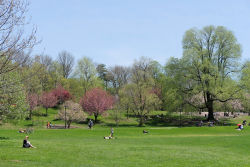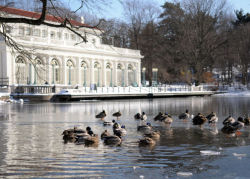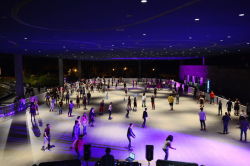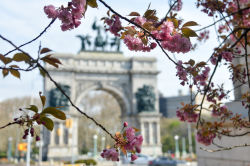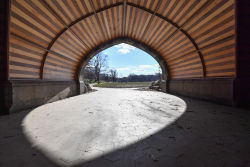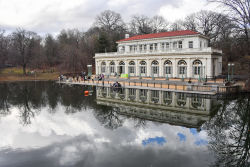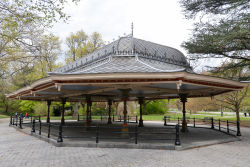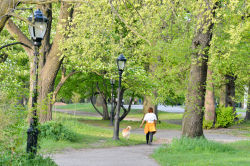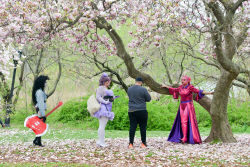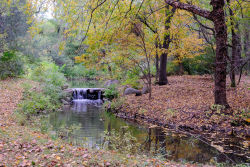Prospect Park
The Daily Plant : Monday, September 22, 2003
SPOTLIGHT ON MONSIGNOR MCGOLRICK PARK’S PAVILION—BROOKLYN’S LITTLE PIECE OF FRANCE
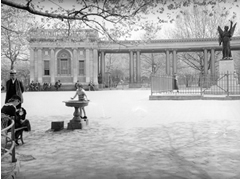
Throughout New York City, structures within parks are often afterthoughts, secondary to the park’s horticultural design and recreational facilities. But in a handful of parks, the structures within the park define the park itself. One of these structures is Monsignor McGolrick Park’s Shelter Pavilion. The pavilion, which is currently undergoing a $2.5 million renovation, is the point of departure for the landscaping of the entire park. Originally designed in 1910 by the architectural firm of Helmle and Huberty, (who also designed Prospect Park’s Boathouse in 1904 and Tennis House in 1910). Modeled on the Grand Trianon at Versaille, Shelter Pavilion is a crescent-shaped open arcade with small buildings at each end, designed to look as if it could be at home in the estate gardens of a French aristocrat. As if to pay homage to the beauty of the structure, 100-year old trees line the radial walks that lead away from the pavilion, creating long, shady walkways comparable to Central Park’s Literary Walk. It’s a piece of landscape design that is typically French, and very rare to find in American parks. By restoring the pavilion, Parks & Recreation’s designers will also restore the landscape and character of the park itself.
In the current reconstruction, Parks & Recreation is restoring the pavilion to its original design. Two new roofs will be installed—one over the pavilion itself and another over one of the pavilion’s end buildings. The pavilion’s roof has been missing for years and so Parks & Recreation’s reconstruction will correct a long-standing aesthetic imbalance. "Basically, what we’re doing is restoring an historically accurate, but missing element," said John Krawchuk, Parks & Recreation’s Director of Historic Preservation.
The undersides of the roofs—otherwise known as the pavilion’s ceilings—will also be restored. The delicate woodwork, which has suffered from water damage, will be restored, and the draining system will be corrected to prevent future deterioration. Parks & Recreation’s construction teams will also restore the pavilion’s walls, which have been obscured and degraded by pigeon droppings. Finally, the pavilion’s comfort stations will be restored, long-hidden in the pavilion’s end buildings. When completed, Parks & Recreation’s designers are hoping that families that have been using the park for years will be inspired to cherish and respect Brooklyn’s little piece of Europe.
MANHATTAN BLOOD DRIVE A SUCCESS
A blood drive held in the Arsenal last week was a huge success thanks to its organizer, Hedi Piel, and those 98 Parkies that gave blood. On Thursday, September 11 and Friday, September 12, the Arsenal Gallery was filled with nurses in blue scrubs, stretchers with Parks employees on them, lots of juice and cookies to reenergize those that donated blood, and, of course, lots of blood. Twenty-one additional offered to donate blood but did not meet the requirements set by the New York Blood Center. The 98 that did donate came from Manhattan Borough (21 donors), the Arsenal (21 donors), Central Park Conservancy (22 donors), Arsenal West (19 donors), and Arsenal North (5 donors). Other Parkies who rolled up a sleeve, including 6 donors from the Brooklyn Borough and the Central Park Zoo.
QUOTATION FOR THE DAY
"It is no use to blame the looking glass if your face is awry."
Nikolai Vasilievich Gogol
(1809-1852)
Check out your park's Vital Signs
Clean & Safe
Green & Resilient
Empowered & Engaged Users
Share your feedback or learn more about how this park is part of a
Vital Park System


